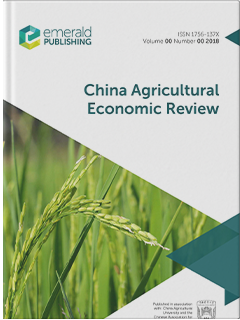Digital financial inclusion and vulnerability to poverty: evidence from Chinese rural households
IF 4.6
2区 经济学
Q1 AGRICULTURAL ECONOMICS & POLICY
引用次数: 24
Abstract
PurposeDigital finance has the transformative power to realise financial inclusion. However, evidence on the relationship between digital finance and poverty reduction remains limited. This study examines the mitigating effects of digital financial inclusion (DFI) on vulnerability to poverty in rural China, explores potential mechanisms at the micro-level, and investigates the external conditions for DFI to validate these effects.Design/methodology/approachRural household data from the China Labour Force Dynamics Survey and the regional DFI index compiled by Peking University are used. The probit and mediation effect models are employed to assess the impacts of the DFI on vulnerability to poverty and explore its mechanisms, with an appropriate instrumental variable to mitigate potential endogeneity.FindingsDFI can mitigate vulnerability to poverty in Chinese rural households. Specifically, both sub-indices – coverage breadth and depth of use – have a significant effect. Further analyses based on the mediation model show that improving agricultural productivity, stimulating entrepreneurial activities and promoting non-agricultural employment are the core mechanisms for alleviating poverty vulnerability. Heterogeneity analysis shows that DFI is pro-poor and benefits those who lack economic opportunities. Moreover, adequate endowment in rural households, such as production and human capital, is an external condition for digital finance to mitigate vulnerability to poverty.Originality/valueThis study is among the first to examine the vulnerability-mitigation effects from the perspective of digital finance development, relying on data from a large-scale, nationwide household survey and the regional DFI index. It also checks for the mechanisms and heterogeneity of the effects, which prove the effects can help balance efficiency and equity.数字金融普惠与贫困脆弱性:来自中国农村家庭的证据
数字金融具有实现普惠金融的变革力量。然而,关于数字金融与减贫之间关系的证据仍然有限。本研究考察了数字普惠金融(DFI)对中国农村贫困脆弱性的缓解作用,探讨了微观层面的潜在机制,并考察了DFI验证这些效果的外部条件。设计/方法/方法使用中国劳动力动态调查中的农村家庭数据和北京大学编制的地区DFI指数。本文采用probit和中介效应模型来评估DFI对贫困脆弱性的影响,并探讨其机制,并采用适当的工具变量来缓解潜在的内生性。sdfi可以减轻中国农村家庭的贫困脆弱性。具体来说,覆盖广度和使用深度这两个分项指标都有显著的影响。基于中介模型的进一步分析表明,提高农业生产率、刺激创业活动和促进非农就业是缓解贫困脆弱性的核心机制。异质性分析表明,DFI有利于穷人,使缺乏经济机会的人受益。此外,农村家庭拥有充足的生产和人力资本等禀赋,是数字金融减轻贫困脆弱性的外部条件。原创性/价值本研究是第一批从数字金融发展的角度考察脆弱性缓解效应的研究之一,研究数据来自大规模的全国家庭调查和区域DFI指数。检验了效应的机制和异质性,证明了效应有助于平衡效率和公平。
本文章由计算机程序翻译,如有差异,请以英文原文为准。
求助全文
约1分钟内获得全文
求助全文
来源期刊

China Agricultural Economic Review
AGRICULTURAL ECONOMICS & POLICY-
CiteScore
9.80
自引率
5.90%
发文量
41
审稿时长
>12 weeks
期刊介绍:
Published in association with China Agricultural University and the Chinese Association for Agricultural Economics, China Agricultural Economic Review publishes academic writings by international scholars, and particularly encourages empirical work that can be replicated and extended by others; and research articles that employ econometric and statistical hypothesis testing, optimization and simulation models. The journal aims to publish research which can be applied to China’s agricultural and rural policy-making process, the development of the agricultural economics discipline and to developing countries hoping to learn from China’s agricultural and rural development.
 求助内容:
求助内容: 应助结果提醒方式:
应助结果提醒方式:


